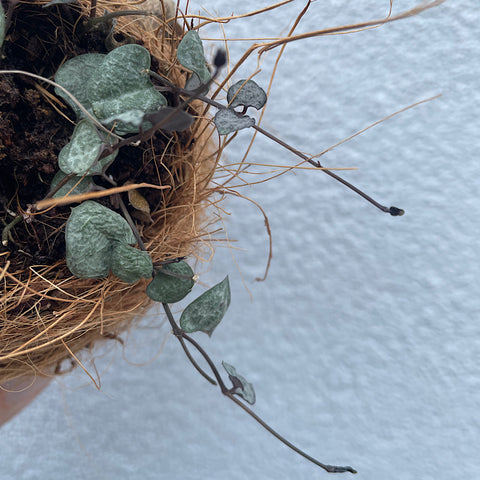
When Do I Water My Plant?
This is usually the first question I am asked about plants and the most common too. Others include.... How much water do I give this plant? Do I give it a water once a week or twice a week?
So here's the answer.....
'Listen to Your Plants'
When you start to listen your plants they will very kindly tell you when you need to water them. Now I don't mean to pick up your plant and listen to it whisper to you that its parching because number one your plant can't communicate through language and two you'll just look ridiculous!
How do plants tell us that they need water? What are the signs to look out for and how can we check? I am going to go through the different signs in this blog.
If you have been following generic guidelines on plant labels, it is setting you up to fail. It is costing you money having to replace plants that have been overwatered or maybe even underwatered.
At Artful Green we want to help you Save money and understand how to care for your plants.
When I see those generic plant labels and it says 'water once a week' I want to scream 'NOOOOOOO'. Every environment is different, all homes/offices or where ever you have your plants are different to the next so each plant has to be treated differently depending on the place you have and the type Your home environment has huge influence on the watering and care of your plants. A plant that requires bright light and little water such as a String of Pearls, hanging this plant in a dark corner will not help it grow well and it will not drink the water you have given it. Therefore it is sitting in the wet, in the dark. A recipe for disaster.
If your plant is in a bright room that is hot and dry your plant will need regular watering, again WAIT for the signs before watering.
'I kill Plants, I cant keep plants alive'.
Sure no wonder I've heard this said so many times at the Markets and Workshops especially if you have been watering by the 'Once a week' method or 'I usually give it a drink when I am having a drink' you have just overwatered your plant.
Overwatering Equals Dead plants
We have all overwatered and killed plants at some stage, I have been guilty in the past of the 'water left in a glass coming down the stairs in the morning and not wanting to waste the water, just poured it into the nearest plant' method, obviously resulting in a drowned plant. Mistakes have been made so lets learn from that because Yes you can keep them alive, its very simple, you just need to know the signs.

It is important to look at how your plant is behaving. I wish those labels said just have a look for changes in your plant's appearance, instead of 'watering' once a week but even how the plant is behaving can be confusing.
Signs of overwatering are brown leaves that feel soft and limp, yellowing leaves, stunted growth during their peak growing period, blisters or lesions on the plant and wilting.
However..... some of these occurrences can also be a sign of underwatering too! This all sounds very confusing, I know, but there is one thing that will be a sure sign of which one it is.
Check The Soil
a.  b.
b. 
You can test your moisture levels by simply sticking your finger in the soil, about an inch depth or have a look and see has a little gap formed between the soil and the pot, like in picture b which is a sure sign of underwatering because the soil has shrunk due to lack of water.
If your soil is still wet and your plant is showing signs of distress, overwatering is likely the culprit.
Overwatering suffocates your plant. Roots need oxygen to survive, otherwise, they will rot and die. Even if your plant has excellent drainage, keeping your soil constantly sitting in water doesn’t allow enough air to reach the roots. Root rot from too much water looks like slimy, grey, or brown roots.
If your plant is an open top Kokí stick your finger down into the soil and feel if it is dry. If it is dry it needs a good drink of water. Unless you leave your Kokí constantly sitting in water is very unlikely you will ever overwater it.
Open top Kokí can be watered from above and fully covered Kokí can be steeped in a bowl of water for 15-20mins. I may ask you to lift it on occasion to feel the weight.
Check For Pests and Smell
Other signs of overwatering are pests and an odour from your plant. A lot of pests, like gnats, thrive in damp places. You will see these tiny black/brown flies crawling, flying or hopping on and around your plant if they are present, believe me you’ll know if your plant has knats. If you follow our water method you will not get knats in your Kokí because unlike potted plants there is very little soil exposed making it difficult for knats to lay eggs.
Bacteria and fungi also grow in the moisture, making your plant give off an unpleasant odour. Root rot also can get stinky! Another advantage of the Coco fibre in our Kokí is they are disease/fungus resistant unlike the humid conditions in plastic pots.
A Plant Needs Water.....
When plants have discoloured brown leaves, dry or crispy and even wilting could mean underwatered.
Wrinkles on leaves is another tell tale sign of underwatering especially with succulents, String of Pearls, String of beads etc

In the above photo, this String Of Hearts is thirsty, have a look at the wrinkles on its leaves, it is saying 'Hello I'm thirsty here'. When your plant has wrinkly leaves it needs watering and I would give it a good drink.
Some Kokí may dry a little quicker, especially with central heating and hanging Kokí as they are higher in the room and exposed to dry air, you may need to change where you hang it so you are not constantly watering.


This Scindapsus pictus, in the above images, is clearly underwatered, look at how the leaves have curled. Also the soil has shrunk and moved away from the sides of the pot creating a gap. This also happens with Kokí and you may notice the fibres/threads are loose because the soil has shrunk inside and the plant needs watering.
Now check out the pictures below of the Scindapsus pictus, 24hrs after watering, look at how the leaves have opened back up and the gap has disappeared because the soil expanded with the water. Now your plant is happy and can be enjoyed.


Check The Weight
Another indicator that your plant is thirsty is to hold it either in its Kokí or plastic nursery pot. If it is light as a feather there is no water in the soil so it will need watering, if it is heavy then there is water in the soil and it does not need watering.
Over time you will get to know how your plant looks and feels when it is happy and they will bring you so much pleasure.
Its all about Listening To Your Plants!
Stephanie

Leave a comment